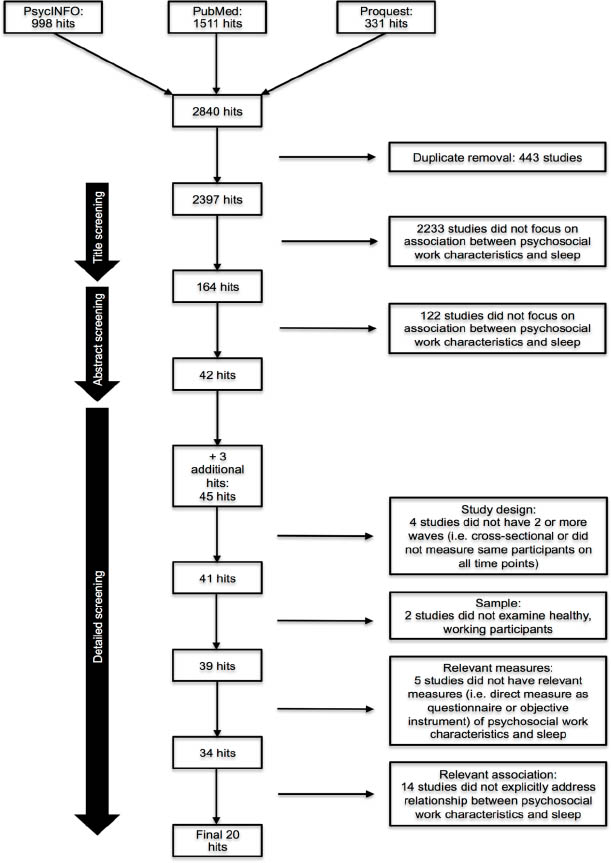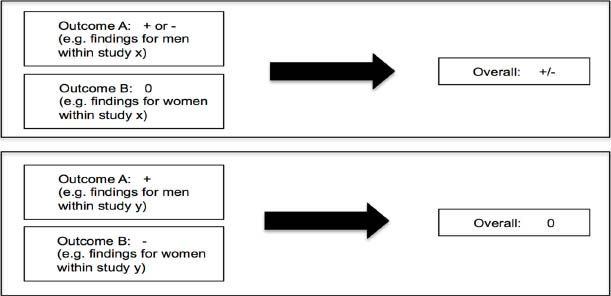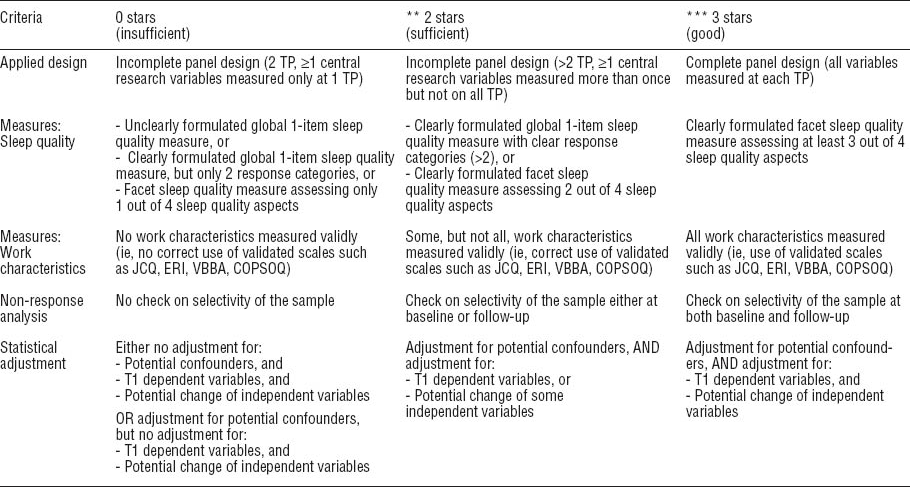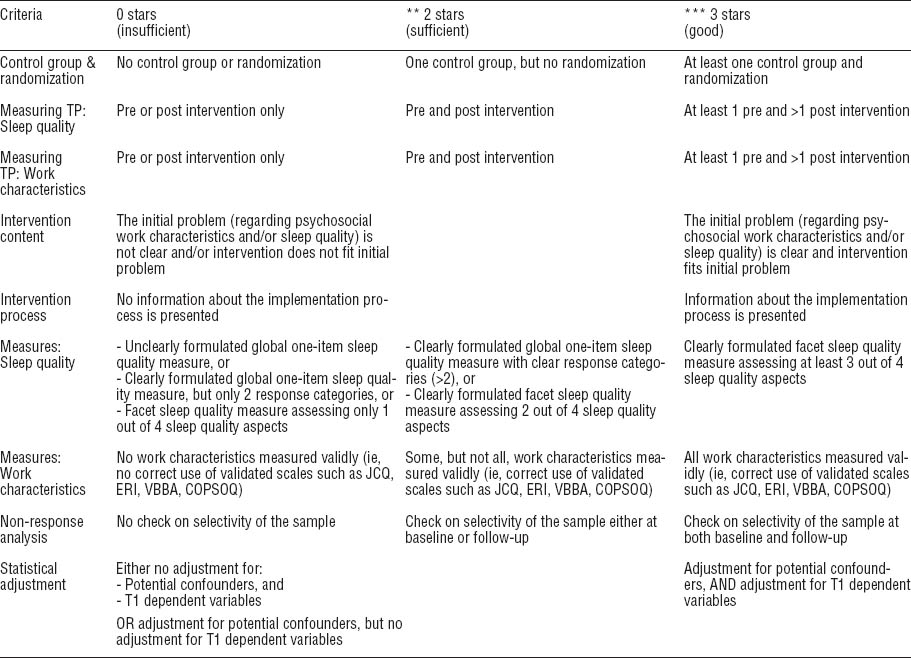Sleep problems are highly prevalent in modern society. Approximately one third of people in Western countries experience sleep problems (eg, short sleep duration, disturbed sleep continuity, overall dissatisfaction with sleep) multiple times a week and 7–9% can be diagnosed with insomnia according to DSM-IV criteria (1–3). Self-reported insomnia symptoms, also referred to as poor sleep quality in the current study, includes ≥1 of the following complaints (4): (i) difficulty initiating sleep, (ii) difficulty maintaining sleep (iii), waking up too early, or (iv) non-restorative sleep. Individuals must experience ≥1 symptoms for ≥3 nights per week to meet the criteria of poor sleep quality. To be diagnosed with clinical insomnia disorder, insomnia symptoms must be present longer than one month and individuals must experience daytime consequences in social, occupational or other areas of daily life (1).
Poor sleep quality has been linked to several health problems such as cardiovascular disease (5, 6), obesity (7), diabetes (8), depression and anxiety (9–11), and is a risk factor for mortality (12–14). Previous research has shown that (chronic) stress is an important antecedent of poor sleep quality and that work can be an important cause of stress (15). Many work-related stressors are psychosocial in nature (16). Psychosocial work stressors refer to the job content including functional and social elements (eg, excessive job demands, low job control, low social support at work) (17). Considering the link between stress and sleep quality on the one hand, and work and stress on the other, one may hypothesize that unfavorable psychosocial work characteristics (“stressors”) are related to reduced sleep quality.
Indeed, several studies have found a relation between work-related psychosocial stressors (ie, high workload, job strain, cognitive and emotional job demands, job insecurity, bullying) and poor sleep quality (18–23). Likewise, positive psychosocial work factors (ie, social support, job control, organizational justice) have been linked to favorable sleep quality (19, 22, 24). However, most evidence is cross-sectional, preventing the possibility to draw causal conclusions. This is a serious limitation that emphasizes the importance of longitudinal and intervention designs as such designs are needed to make stronger inferences about causality (15, 25–27). Longitudinal and intervention designs also enable examining reversed relations: it seems plausible that if an individual develops poor sleep quality, this might alter the perception of the psychosocial work environment. De Lange et al (28) coined this within-person perceptual change the “gloomy perception mechanism”. However, it is also likely that poor sleep quality influences the actual work situation. Poor sleep quality could lead to fatigue and also to poor work functioning and decreases in performance. Poor work performance, in turn, may also “create” work stressors, such as reduced support from colleagues or supervisors or insecurity (19). This is what De Lange et al (28) define as the “environmental change mechanism”.
We can conclude that it is important to empirically substantiate both normal and reversed relations between work characteristics and sleep quality, which requires at least longitudinal and intervention field study designs. The aim of this paper is to review the existing longitudinal and intervention studies on the assumed reciprocal relation between psychosocial work characteristics and sleep quality. The current systematic review aspires to answer two research questions: (i) do psychosocial work characteristics predict sleep quality (normal relation), and (ii) does sleep quality, in turn, predict psychosocial work characteristics (reversed relation)?
Methods
Study selection
We performed an extensive literature search for longitudinal and intervention research on the association between psychosocial work characteristics and sleep quality (see figure 1 for a complete overview of the search and selection procedure). This review focuses on the concept of sleep quality as defined in the introduction; even though sleep quantity is an important aspect of sleep as well (29, 30), low sleep quantity alone does not suffice to characterize the experience of poor sleep. Therefore, studies only measuring sleep quantity were not included in this review.
A systematic search in three bibliographical databases was carried out [ie, PsycINFO, PubMed (including Medline), Proquest Dissertations and Theses; final search date: 24 September 2012]. Search terms consisted of three groups of keywords: “work characteristics” (eg, job control), “sleep” (eg, insomnia), and “longitudinal design” (eg, prospective). The three categories were combined with the operator AND. Since our aim was to provide a broad overview of current longitudinal and intervention research, we included many search terms for both work characteristics and sleep quality to minimize the possibility of missing relevant studies. For a complete list of all search terms, see table A in the Appendix (www.sjweh.fi/data_repository.php). For the same reason, we did not restrict the search by publication year, language, publication type, or population. After removal of duplicates, the initial literature search resulted in 2397 hits.
The first author scanned all titles for relevance, which resulted in 164 remaining papers. Studies concerning work time or shift work were not included in this review, as work time per se is not considered a psychosocial work characteristic. Subsequently, all abstracts were retrieved and read by the first author. Studies were excluded if it was clear from the abstract that they did not examine psychosocial work characteristics in relation to sleep quality (eg, studies focusing on infants). After screening all abstracts, 42 papers remained; 2 additional papers were added after consulting an expert in work–sleep research and 1 additional paper was retrieved after examining the reference lists of the 42 remaining papers. These 3 additional papers resulted in a total of 45 complete papers to be read.
While reading complete papers, studies were included based on the following criteria: (i) study design: ≥2 measuring points, (ii) sample: healthy, working individuals, (iii) relevant measures: direct measure of work characteristics and sleep quality by means of a questionnaire or objective instrument, and (iv) relevant association: relationship between psychosocial work characteristics and sleep quality explicitly addressed; some studies examined work characteristics and sleep quality (ie, as covariates) but did not statistically test and report statistics on the direct relation between those variables. If a study did not comply with all criteria, it was excluded. After reading complete papers and applying inclusion criteria, 20 papers remained, of which two studies (31/32) were taken together as one study, since the second paper was a follow-up measurement of the initial study. Moreover, two studies (33, 34) examined the same cohort, one of which concentrated on older workers. Both papers were included in this review and examined independently. Based on this selection procedure, 19 studies (ie, 20 papers) were included in the present review.
Description and evaluation of results
Part I: Evaluation of all studies
The results section of this review consists of two parts. The first part gives an overview of results of all included studies. Longitudinal studies examined a wide range of work characteristics of which some were only investigated by two or three studies. Additionally, studies used incomparable analytic approaches (ie, logistic regression analysis and structural equation modeling). Therefore, it was not viable to perform a formal meta-analysis focusing on effect sizes of associations between each work characteristic and sleep quality [eg, Hunter and Schmidt’s method (35)]. However, calculating a standardized index of convergence (SIC) is a feasible possibility to nevertheless quantify strength of the presented longitudinal evidence whilst avoiding mere “vote-counting” (36, 37). SIC can be defined as:
In this formula, n[positive] corresponds to the number of studies reporting a significant positive association, n[negative] corresponds to the number of studies reporting a significant negative association, and n[total] corresponds to the total number of studies examining the association between a work characteristic and sleep quality (including studies that were not able to detect a significant relationship) (37). The values of SIC can range between -1 (all studies reported a negative relationship) and +1 (all studies reported a positive relationship). If a SIC value is close to 0, evidence is either inconsistent or almost none of the studies were able to detect a significant association. SIC thus displays the degree of consistency of the evidence regarding a relation.
By combining the SIC score with the number of performed studies on a certain relationship (eg, job demands and sleep quality), the strength of evidence for this relationship can be estimated. Table 1 shows possible outcomes for each studied relationship, depending on the SIC value and number of performed studies (37).
Table 1
Strength of evidence for studies included in this review based on number of studies assessing each relationship and the corresponding standardized index of convergence (SIC) values. [0=inconsistent/no evidence for a positive/negative relationship; -/+=limited evidence for a positive/negative relationship; - -/+ +=moderately strong evidence for a positive/negative relationship; - - -/+ + +=strong evidence for a positive/negative relationship; #=insufficient evidence for a positive/negative relationship.]

Several studies reported multiple statistical tests. In this review, the most advanced analysis was used for SIC calculation (eg, a model that adjusted for confounders was preferred over a model without confounder adjustment). Moreover, some studies reported multiple aspects of sleep quality (ie, disturbed sleep and awakening problems, development and maintenance of poor sleep quality) or stratified sleep quality outcomes by gender (ie, reported outcomes for men and women separately). These separate outcomes were taken together into one rating according to a decision tree (figure 2), and this rating was subsequently included in our SIC calculation (36).
Part II: High-quality studies
To draw conclusions about the relations between work characteristics and sleep quality, one should rely more strongly on findings from high-quality studies. As such, apart from a complete overview of the results of all longitudinal and intervention studies (Results: Part I), we also performed a separate analysis of “high-quality only” studies (Results: Part II). Therefore, all studies were rated in terms of quality criteria. Two sets of evaluation criteria were developed: one set to assess the quality of the longitudinal studies (see table 2) and one set for the quality of intervention studies (see table 3). The criteria were based on well-acknowledged insights from longitudinal and intervention research (25–27, 38–40). For each quality criterion, studies could be assigned zero, two, or three stars, corresponding to the quality ratings “insufficient”, “sufficient”, and “good”.
Data extraction and quality assessment
The first author extracted data from all studies containing necessary information to assess a study’s quality on each criterion. The second author verified all extractions, and discrepancies were discussed until consensus was reached. Next, the first and second author rated all studies independently and quality was determined according to the developed rating schemes (tables 2 and 3). In case of disagreement on a quality assessment, this rating was resolved by consensus (initial convergence was on 96% of all ratings). To confirm whether our information about the studies was valid, all first authors of the 20 included papers (19 studies) were contacted by e-mail (longitudinal: 14 authors of 16 studies, intervention: 3 authors). Similar to De Lange et al (26), we explained the aim of our study and provided authors facts about their study that could be translated into quality ratings. After two months, 13 of the 17 authors had returned the factsheet (76% response rate).
Taken together, the authors responding to our e-mail checked 82 comments of which they felt that 7 were not entirely correct (91% agreement rate). We took this additional information into consideration and, in case of agreement, the quality ratings were adjusted accordingly. The comments resulted in six minor changes of our initial quality rating (41–44).
A non-response analysis was performed to examine whether study quality differed between responding and non-responding authors. The mean quality scores (average number of achieved stars per study) of both groups were compared using an independent samples t-test, which was not significant [t(17) = -1.59, P=0.13 (two-tailed): studies from non-responding authors [mean 1.76, standard deviation (SD) 0.41] did not significantly differ in quality assessment from studies of those who did respond (mean 2.13, SD 0.46)].
Since authors differ in terminology regarding sleep quality, we carefully checked whether each study examined sleep quality as defined in the introduction. Some authors distinguish between awakening problems and sleep disturbances (45), which are both aspects of sleep quality. To avoid confusion in the results section of this article, we employed the terminology used by the authors when reporting on these outcomes.
Results (Part I: evaluation of all studies)
Longitudinal studies
Descriptive and background information
Table B of the Appendix (www.sjweh.fi/data_repository.php) presents detailed information on the 16 longitudinal studies included in this review. In most studies, a heterogeneous group of employees was examined (N=13, mixed occupations) (33, 34, 41–43, 45–52), and groups of mixed gender were investigated in the majority of studies [N=11; in two studies, groups with predominantly male participants were examined (46, 53), and in three studies predominantly women (42, 49, 54)]. All but one study were performed in Western countries (33, 34, 41–43, 45–52, 54, 55) (N=15, mostly European). The remaining study was conducted in Japan (53). Length of time lags (ie, period between two measurement points) ranged from 3 months to 15 years and sample sizes ranged from 816–18 695 participants.
Study design and quality assessment
A full panel design was used in four studies (43, 45–47). In most studies, however, an incomplete panel design was used with sleep quality measured at all time points and psychosocial work characteristics only at baseline (N=11) (33, 34, 41, 42, 49–55). The remaining study also used an incomplete panel design, but had ≥2 time points (48). All studies relied on self-report measures only; see the Appendix (table B). Seven studies (41, 42, 45, 46, 48, 49, 53) used a clear measure of sleep quality, whereas four studies (43, 47, 50, 55) did not. Only ten studies (33, 34, 41, 42, 45, 46, 48, 49, 53, 54) measured all “their” work characteristics validly. Thirteen studies performed non-response analyses at baseline and/or follow-up (33, 41–43, 45, 46, 48–51, 53–55) (two studies: baseline and follow-up), and the remaining studies did not perform non-response analyses (34, 47, 52). In the majority of studies, logistic regression analyses (N=12) were performed with sleep quality as outcome (33, 34, 41–43, 46, 47, 49–51, 53, 54). Two other studies explored the data with structural equation modeling (45, 48), and one used linear regression analysis (55). All studies investigated normal relations (work characteristics → sleep quality). Reversed relations (sleep quality → work characteristics) and/or reciprocal relations (work characteristics ↔ sleep quality) were examined in two studies (45, 48). Most studied work characteristics were job demands (N=9), (dimensions of) job control (N=10), and social support (N=7). All other work characteristics were examined by ≤3 studies (ie, effort–reward imbalance, organizational justice, influence over decisions, role conflict, and feedback).
The 16 longitudinal studies were rated according to our evaluation criteria (see table 2). For each study, quality is depicted by a number of stars per criterion. Zero stars signify that a study is of insufficient quality on a particular criterion, two stars imply that a study scores sufficient on a criterion, and three stars (highest rating) mean that a study scores good on a specific criterion. Only when a study had at least two stars (sufficient quality) on each criterion, it was classified as an overall high-quality study. This procedure is based on the assumption that studies scoring insufficiently on one or more quality criteria possibly suffer from certain biases, which make it impossible to draw definite conclusions on the effects and may reduce the validity of findings (26). The resulting quality assessments are presented in table 4. Of the 16 examined longitudinal studies three were of high quality (45, 46, 48).
Table 4
Quality evaluation of longitudinal studies. [0=insufficient; **=sufficient; ***=good; 1=applied design; 2=measures: sleep quality; 3=measures: work characteristics; 4=non-response analysis; 5=statistical adjustment.]
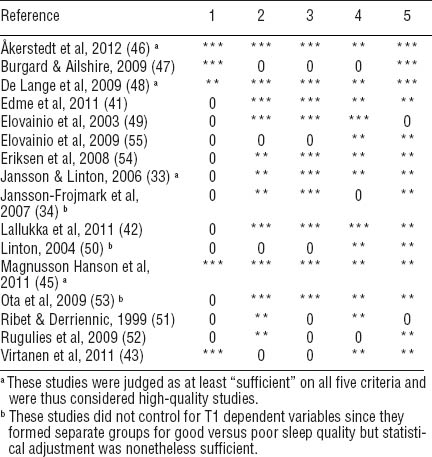
In the first part of the results section all studies are examined. We only discuss work characteristics measured in three or more studies. Outcomes of psychosocial work characteristics that were examined by less than three studies are nonetheless presented in table 5 and the Appendix (table B). In the second part of the results section, we discuss the high-quality studies in more detail.
Table 5
Number of studies and standardized index of convergence (SIC) values for all (normal relation) associations studied in ≥3 studies. [0=inconsistent/no evidence for a positive/negative relationship; -/+=limited evidence for a positive/negative relationship; - -/+ +=moderately strong evidence for a positive/negative relationship; - - -/+ + +=strong evidence for a positive/negative relationship; #=insufficient evidence for a positive/negative relationship.]
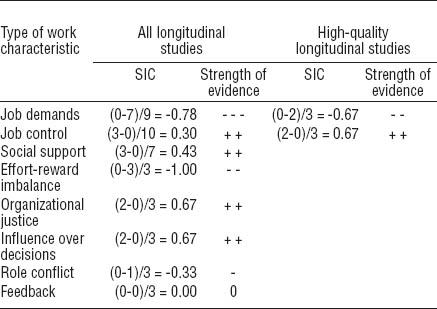
Longitudinal studies examining normal relations: job demands
Nine studies examined job demands as a predictor of sleep quality. A negative relation between job demands and sleep quality was found in six of those studies (33, 34, 46, 48, 51, 54). Employees with higher job demands reported poorer sleep quality than employees with lower job demands. In one additional study, this relationship was found for men, but not women (41). A link between job demands and sleep quality could not be found in the remaining two studies (45, 50), however, in one of those studies (45), the relation was marginally significant. Based on these nine studies the SIC value is: SIC(9)= -0.78, which indicates strong evidence for a negative relation between job demands and sleep quality.
Longitudinal studies examining normal relations: job control
Job control was investigated in ten studies (33, 34, 41, 45–48, 50, 51, 54). Evidence for a significant positive relation between job control and sleep quality was presented in two of these (48, 51). This means that employees who reported more control over their job experienced better sleep quality. In another study, a significant positive effect was found for awakening problems but not for sleep disturbances (45). In the remaining seven studies, no significant effects were found. On basis of these ten studies the SIC value is: SIC(10)=0.30, indicating moderately strong evidence for a positive relation between job control and sleep quality.
Longitudinal studies examining normal relations: social support
The relationship between social support and sleep quality was examined in seven studies (33, 34, 41, 45, 50, 53, 54). A positive relation was found in one of those studies, which indicates that employees reporting higher social support experienced better sleep quality (54). A positive effect of social support on sleep quality was revealed in a second study, but only for awakening problems and not for sleep disturbances (45). In another study, no link between social support and the development of poor sleep quality was found, but the authors could demonstrate an effect on maintenance of poor sleep quality (53). No significant relationship between social support and sleep quality was found in the remaining four studies (33, 34, 41, 50). Based on these seven studies the SIC value is: SIC(7)=0.43, indicating moderately strong evidence for a positive relation between social support and sleep quality.
Longitudinal studies examining normal relations: other psychosocial work characteristics
All remaining psychosocial work characteristics (ie, effort–reward imbalance, organizational justice, influence over decisions, role conflict, feedback, bullying, or job insecurity) were examined in three or less studies. Table 5 depicts the number of studies and SIC values of the (normal relation) longitudinal relationships between psychosocial work characteristics and sleep quality of which a SIC score and strength of evidence could be determined. Outcomes of the remaining studies are presented in table B of the Appendix. There is moderately strong evidence for a negative association between effort–reward imbalance and sleep quality [SIC(3)= -1.00], moderately strong positive evidence for organizational justice [SIC(3)=0.67] and for influence over decisions [SIC(3)=0.67], limited negative evidence for role conflict [SIC(3)= -0.33], and no evidence for a longitudinal relation between feedback and sleep quality [SIC(3)=0.00].
Longitudinal studies examining reversed and/or reciprocal relation
Of the 16 longitudinal studies, 2 also examined reversed and/or reciprocal relationships between psychosocial work characteristics and sleep quality (45, 48). These findings will be described in the same paragraph as the high-quality studies.
Intervention studies
Table C of the Appendix (www.sjweh.fi/data_repository.php) presents the main study characteristics of the intervention studies. Only three intervention studies could be identified, and each of them examined a homogeneous group of employees (31/32, 44, 56). In two intervention studies, a mixed gender cohort was investigated, whereas in one study (two papers) participants were predominantly women (31/32). All studies were conducted in Western countries (Canada, US, and Sweden). Length of time lags ranged from six months to three years and sample size ranged from 100–334 participants.
Study design and quality assessment
In each intervention study, the authors attempted to change psychosocial work characteristics at the workplace (ie, job demands, job control: skill discretion and decision authority, social support, effort–reward imbalance, and/or schedule control) with sleep quality as dependent variable. None of the intervention studies focused on modifying sleep habits. A control group was included in two of the three studies (31/32, 56), but without randomization. In every study, at least one pre- and one post-intervention measurement was included for all variables. In all studies, the initial problem regarding psychosocial work characteristics was clear, the intervention fitted this problem, and information about the implementation process was presented. Studies used self-report measures only. Only one study (44) measured sleep quality with an unclearly formulated 1-item measure. Every study measured all work characteristics validly and performed non-response analyses at either baseline or follow-up. Analyses performed were ANOVA or ANCOVA (31/32), structural equation modeling (56), and oneway analysis of variance with multiple range tests using the least significant difference (LSD) procedure (44).
The three intervention studies were rated according to our evaluation criteria (see table 3). If a study had at least two stars (sufficient quality) on each criterion it was classified as an overall high-quality study. The resulting quality assessments are presented in table 6. Of the three intervention studies examined, one was of high quality (31/32).
In this part of the results section, we consider all three intervention studies. In the second part of the results section, we examine the high-quality intervention study in more detail.
Table 6
Quality evaluation of intervention studies. [0=insufficient; **=sufficient; ***=good; 1=control group and randomization; 2=measuring time points (TP): sleep quality; 3=measuring TP: work characteristics; 4=intervention content; 5=intervention process; 6=measures: sleep quality; 7=measures: work characteristics; 8=non-response analysis; 9=statistical adjustment.]
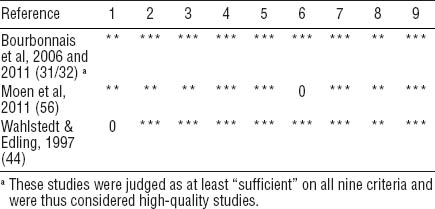
In two of the three intervention studies, most psychosocial work characteristics had improved, however, no significant effects of the work characteristics interventions on sleep quality were found (31/32, 56). In a third intervention study (44), however, a significant positive effect of an increase in skill discretion on sleep quality was revealed, but only at the second follow-up measurement. The manipulation check in this study showed that for all other psychosocial work characteristics, the intervention did not enhance the work characteristics or the work characteristics did not have a significant effect on sleep quality.
Results (Part II: high-quality studies)
Three longitudinal studies (45, 46, 48) and one intervention study (31/32) (described in two different papers) could be categorized as high quality. In the first high-quality longitudinal study (46), job demands and job control were examined in relation to sleep quality (sample: 3077 Swedish employees, mixed occupation). A full panel design was used with one time lag and measuring points five years apart. Data were analyzed with logistic regression analyses. In the second high-quality longitudinal study (48), relations between job demands, job control, and sleep quality were investigated (sample: 1136 Dutch employees, mixed occupation). An incomplete panel design was applied with three time lags and one year between measuring points. Structural equation modeling was used to analyze the data. In the third high-quality longitudinal study (45), the relationship between job demands, job control (only decision authority), and social support on the one hand and sleep quality on the other hand were examined (sample: 3041 Swedish employees, mixed occupation). A full panel design was used with one time lag and measuring points two years apart. Data were analyzed with structural equation modeling. The high-quality longitudinal research contained the two studies examining both normal and reversed/reciprocal relations (45, 48). Thus in the next paragraph, we discuss reversed and reciprocal relations in addition to normal relations.
Regarding job demands, in two of the three high-quality longitudinal studies, a negative effect of job demands on sleep quality was revealed [ie, higher job demands coincided with poorer sleep quality; SIC(3)= -0.67, moderately strong evidence for a negative relation] (46, 48). Moreover, in these two studies a normal relation model fitted the relationship between job demands and sleep quality best, meaning that employees who reported more job demands experiences poorer sleep quality.
Furthermore, in two of three high-quality longitudinal studies, a significant positive link between job control and sleep quality was revealed (45, 48). A significant positive effect of job control on sleep quality (normal relation) was revealed in one study, but no evidence for reversed or reciprocal relations (48). In an additional study, no relations were found between job control and sleep quality [SIC(3)=0.67, moderately strong evidence for a positive relation] (45).
In one high-quality longitudinal study, social support was investigated: no significant link between social support and sleep disturbances was found (45). This study also examined reversed and reciprocal relations and an unfavorable effect of sleep disturbances on social support was found (reversed relation), but no normal or reciprocal relation (45). Additionally, this study differentiated between awakening problems and sleep disturbances and a reciprocal relationship between all three job characteristics (demands, control, support) and awakening problems was found. This means that in addition to a normal relation, a reversed relation was present as well.
In the high-quality intervention study (31/32), it was attempted to influence the work characteristics job demands, job control, social support, and effort–reward imbalance by introducing an intervention team that proposed solutions to improve these work characteristics. Subsequently, these solutions were implemented by the employees (sample: 247 experimental group and 220 control group, Canadian care providers). A pre-intervention measurement was performed right before the intervention started and two follow-up measurements were carried out (one and three years post-intervention). At the first follow-up measurement, an ANCOVA analysis showed that job demands, social support, and effort–reward imbalance significantly improved, whereas job control decreased in both groups. Moreover, no change in sleep quality was found. At the second follow-up measurement, another ANCOVA showed that all psychosocial work characteristics had significantly improved compared to the pre-intervention measure. Again, no change in sleep quality was found. To summarize, no significant effect of a change in psychosocial work characteristics on sleep quality could be established. Reversed and reciprocal relations were not examined.
Discussion
Sleep is the recovery activity par excellence and of crucial importance for psychological well-being, physiological health, and performance (15, 57). As such, it is essential to determine the main causes of poor sleep quality as to reduce them and restore good sleep quality. Based on occupational health theories, work-related stress and adverse psychosocial work characteristics are assumed to be important determinants of poor sleep quality (16, 19, 57). In 2006, a narrative review of mainly cross-sectional studies indeed showed that psychosocial work-related stress is closely related to impaired sleep quality (15). In line with this, a recent meta-analysis showed that several adverse psychosocial work characteristics (ie, workload, role conflict, role ambiguity, organizational constraints, lack of control, and interpersonal conflict) were significantly related to poor sleep quality (58). Although insightful, these previous reviews were predominantly based on cross-sectional studies and consequently do not allow for causal inferences. The main aim of the current review paper was to render insight into the association between psychosocial work characteristics and sleep quality by reviewing longitudinal and intervention research on this topic. Sixteen longitudinal and three intervention studies could be identified, mostly studying normal relations (ie, the effect of work on sleep quality) and only a small number of studies examined reversed relations (sleep quality → work characteristics). It is noteworthy that most longitudinal and intervention studies were conducted from 1995 onwards. This indicates that there seems to be a growing research interest into this topic. In our review, the quality of all included studies was established by means of quality criteria regarding design, measurement quality, and appropriateness of analyses. The rationale for this is that more trust can be put in those published studies with design, measurements, and statistical analyses of sufficient or good quality. Our review showed that only one intervention and three longitudinal studies scored at least sufficient (ie, sufficient or good) on all quality criteria.
The first research question was whether psychosocial work characteristics predict sleep quality (normal relation). Our review could only answer this research question for two psychosocial work characteristics, ie, job demands and job control, since these were the only work characteristics that were examined in a large number of studies, including several high-quality studies. Based on high-quality longitudinal research, it can be concluded that higher job demands are associated with lower future sleep quality. The same conclusion can be drawn when we not only focus on high-quality studies, but include all longitudinal research on job demands and sleep quality. Regarding job control, both high-quality and all other longitudinal studies revealed moderately strong evidence for a positive link between job control and sleep quality. These findings confirm previous cross-sectional research on this topic and are in line with several occupational health theories [eg, the Demand–Control Model (16)] that emphasize the important role of high job demands and low job control in stress-related outcomes such as poor sleep quality.
It is thus safe to conclude that job demands and job control are linked to later sleep quality. The next question is how strong and relevant are these associations? A closer inspection of the odds ratios (OR) and betas (ß) indicates that effect sizes for demands and control were small to moderate (ie, significant OR ranged from 1.24–2.05 and ß from -0.04–0.07; printed bold in table B of the Appendix). This implies that not a very high proportion of variance in sleep quality seems to be influenced by these job characteristics. This was to be expected considering that job demands and control are only two of many factors determining sleep quality [see also Zapf et al (40)]. Other (partly related) antecedents are for instance health, lifestyle (eg, alcohol consumption), and stressors in private life (20, 59). Moreover, besides demands and control, also other psychosocial work characteristics determine the psychosocial profile of work and may show to be relevant predictors of sleep quality (eg, bullying). As such, the effect size of the total psychosocial work quality may be higher than individual effect sizes of job demands and control. However, all other psychosocial work characteristics (eg, social support, influence over decisions, organizational justice, effort–reward imbalance, role conflict, bullying and feedback) were only examined in a limited number of (high-quality) longitudinal studies. More high-quality research is needed to explore the longitudinal relation between all individual psychosocial work characteristics and sleep quality, as well as their combined effects.
When distinguishing between the longitudinal and intervention studies of our review, we can draw several conclusions. First, only very few studies examining the association between psychosocial work characteristics and sleep quality applied an intervention design. Second, most evidence for the relation between psychosocial work characteristics and sleep quality was found in longitudinal studies; the three intervention studies provided little support for an effect of work characteristics on sleep quality. Third, this lack of significant findings within intervention studies is partly due to program failures (27): the intervention in one-third of the intervention studies did not enhance all intended work characteristics (ie, the manipulation of work characteristics was unsuccessful). Therefore, we must be cautious in drawing conclusions about a link between psychosocial work characteristics and sleep quality from existing intervention research.
The second aim of our review was to examine whether sleep quality has an effect on later psychosocial work characteristics (reversed relation). In one of the two high-quality longitudinal studies, cross-lagged modeling provided some evidence for a reversed relation between sleep disturbances and social support as well as reciprocal relations between work characteristics (ie, job demands, job control, and social support) and awakening problems. However, as only two studies examined reversed relations: so far, research does not enable firm conclusions to be drawn on reversed or reciprocal relations. Nonetheless, reversed and reciprocal relations between psychosocial work characteristics and sleep quality are highly plausible. It may well be that work characteristics and sleep quality mutually influence each other in a circular process (28, 60). Therefore, it is important to empirically substantiate different types of relations (normal, reversed and reciprocal) in future research (61).
Strengths and limitations of the current review
We believe that one strength of our review is that the literature search and synthesis of evidence were both extensive and well-structured.
The added value of the current review in comparison to preceding reviews is: (i) its emphasis on both normal and reversed, across time relations (ie, only longitudinal and intervention designs were included); (ii) its specific focus (ie, on psychosocial work characteristics and sleep quality); (iii) its complete and up-to-date overview of longitudinal and intervention research on this topic (all relevant research until 2012 is included); and (iv) the fact that we carefully developed two sets of quality criteria to assess quality of longitudinal and intervention research on this topic. We believe that a good quality assessment is very relevant when reviewing empirical studies, as it enables putting more trust in the findings of the most validly conducted studies. We hope that future researchers will benefit from these quality criteria and will be encouraged to continue conducting high-quality research in this area. Though we think that this study’s quality criteria include the most important indicators, others could also be considered in future research (eg, assessment of selection, attrition, performance, and detection biases).
A limitation regarding the evaluation of strength of evidence is publication bias, ie, significant results being published more often than insignificant results. Since it is almost impossible to gather all non-published studies, our findings could represent an overestimation of the actual relation between work characteristics and sleep quality. However, as most included studies examined more than one work characteristic, non-significant results were also revealed, perhaps attenuating publication bias in our review. Another issue is that SIC scores were calculated with results based on the most advanced analysis. Studies varied in adjustment for covariates, which could possibly mean including results with crude associations but also including overly adjusted results. However, the results before and after adjustment did not differ significantly in almost any of the studies.
Limitations of previous research
From our review, it becomes clear that research conducted thus far has been restricted by several limitations. First, it revealed that not much longitudinal research on the relation between psychosocial work characteristics and sleep quality has been conducted, and especially high-quality longitudinal and intervention studies are scarce. The scarcity of intervention research is especially unfortunate since intervention designs provide a window of opportunity to examine normal as well as reversed relations in real-life work settings (27).
Another key issue of previous research is external validity. Most of the studies included in our review are based on convenience samples and not occupational sub-cohorts of population-based samples, which makes it more difficult to generalize results to the general working population.
Thirdly, longitudinal and diary studies assessing sleep quality with independent, objective instruments are missing. Some diary studies measuring sleep quality with independent measures, such as polysomnography or actigraphy, exist; however, these studies focus mostly on general (work) stress rather than specified psychosocial work characteristics (62, 63).
Another, yet related point, is the optimal time-period between measuring exposure to adverse psychosocial work characteristics and measuring outcome variables as for example poor sleep quality. One may expect poor sleep quality to occur shortly after for instance a period of high pressure at work. Therefore, longitudinal designs with only two measuring points, a very long follow-up, and time lags of several months or years may noticeably underestimate the real effects of short term work stressors. Diary study designs, which include several repeated within-person measurements over a short period of time, could be used in future research to detect possible short-term fluctuation in both work characteristics and sleep quality.
A fifth limitation it that the majority of longitudinal and intervention studies included one or more suboptimal elements: many studies applied insufficient designs (eg, incomplete panel design; 63% of the included studies) or employed non-valid measures (sleep quality: 26%; work characteristics: 32%). These suboptimal characteristics reduce the validity and value of the study findings and make it hard to draw definite conclusions. This does not imply, however, that these studies cannot provide us with useful information. We can extract important information about which work characteristics might be more likely to have an effect on sleep quality, but more high-quality research is needed to draw definite conclusions. Another issue is that studies measured the central work characteristics job demands and job control in a different manner. Job demands refer to (high) workload and instruments usually assess job demands by measuring time pressure (64). In some studies (using the Job Control Questionnaire) however, job demands were assessed as a combination of time pressure and role conflict. Comparing instruments that measure job demands in a different manner could cause differences in results. Likewise, the measures and operationalizations of job control varied from decision authority to skill discretion (64). Since studies included in this review used different operationalizations of both job demands and job control, a comparison between these studies is not without complications and conclusions can only be drawn carefully.
A sixth limitation is that most high-quality prospective studies focused on the link between job demands and job control and sleep quality, but did not take into account potential underlying mechanisms such as, for example, worrying or rumination (ie, perseverative cognition). One can reason that work stressors impact sleep quality via cognitive processes (ie, mediate) such as perseverative cognition or physiological arousal. When one experiences stress from high workloads or little control over one’s job, this might increase stressful cognitive activity at bedtime, induce physiological arousal (ie, a biological mechanism), and consequently reduce sleep quality.
A final shortcoming of research so far is that reversed and reciprocal relations were only examined in two studies, and none of the intervention studies attempted to enhance sleep quality as an intervention to improve work evaluation and performance.
Implications for future research
Based on the described limitations of previous research, we make some suggestions for future research. One of our main appeals is to increase the number of high-quality longitudinal and intervention studies. Specifically, future research should include full panel designs with several measurement points and varied lengths of time lags (diary as well as longitudinal research). This may enable researchers to better understand the potential normal, reversed, and reciprocal relations between psychosocial work characteristics and sleep quality, and to examine the possible underlying mechanisms, such as rumination and worry, as well as detecting fluctuations in both psychosocial work characteristics and sleep quality. Regarding reversed and reciprocal relations, it would be interesting to also examine whether suboptimal sleep quality influences the change in experience of psychosocial work characteristics (ie, within-person change in perception) and/or the actual change in the work situation (eg, receiving less collegial support due to fatigue-related poorer work performance) (28).
As a second recommendation, we emphasize the value of using high-quality measurement instruments when collecting future data. In previous longitudinal studies, only self-report questionnaires were used to measure work characteristics and sleep quality, and some of these questionnaires were not validated or did not validly measure the constructs of interest. We propose to apply validated measurement scales solely, for instance the Job Content Questionnaire (65) or Dutch Questionnaire on the Experience and Evaluation of Work (66), to measure psychosocial work characteristics and the Jenkins Sleep Questionnaire (67) or Karolinska Sleep Questionnaire (68) to measure sleep quality. Moreover, studies using objective sleep quality measures are rare; however, it is not impossible to collect such data. It would be of value to combine self-report measures with so-called “independent, objective measurements of sleep parameters”, such as actigraphy [ie, SenseWear Armband (69)] or 1-Channel EEG [ZEO-sleep manager pro (70)]. These measures are user-friendly, unobtrusive, do not rely on retrospective assessments of sleep quality, and are especially useful in field and intervention settings (69, 70).
For further suggestions regarding the design, measurements and analyses of future research, we refer to the quality criteria that were developed for this review (tables 2 and 3). In our opinion, these quality criteria constitute a valuable and practical checklist for designing future research.
Practical implications
High job demands and low job control are associated with poor sleep quality. Periodic organizational risk analyses of the psychosocial work environment can help to notice suboptimal combinations of job demands and job control and optimize psychosocial working conditions. A work profile including high, but not too high, job demands in combination with sufficient job control results in challenging jobs (16, 17) that can be expected to contribute to favorable sleep quality, from which both employees and organizations will benefit in terms of employee well-being and performance (19).


